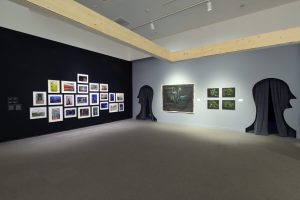

Installation view, Mitchell Wiebe’s VampSites, 2019 MacKenzie Art Gallery photo by Don Hall
VampSites
VampSites is an exhibition-as-temporary-occupation. Combining making and showing, employing a surreal personal lexicon and mythology of colours and textures, motifs and narratives, Mitchell Wiebe imports the chaos and theatre of his studio into the well-lit, rational architecture of the art museum. The artist then adopts a distinctive persona who emerges from the same fictive world inhabited by his array of fantastical animalesque characters.
Wiebe openly embraces an artificial and attention-grabbing mode of address; he loves the cheap attraction of the fun house, the appeal to regressive fantasy, exuberance with a touch of poison. Optical effects coincide with subcultural references, spatial illusion reverberating with the visceral swoop and swish of paint; Wiebe plays with the procedures and boundaries of painting, and with the ebb and flow of its credibility. To vamp is to build a rhythmic ground for improvisation; it also means to seduce in the night, to draw us into an alternate life.







